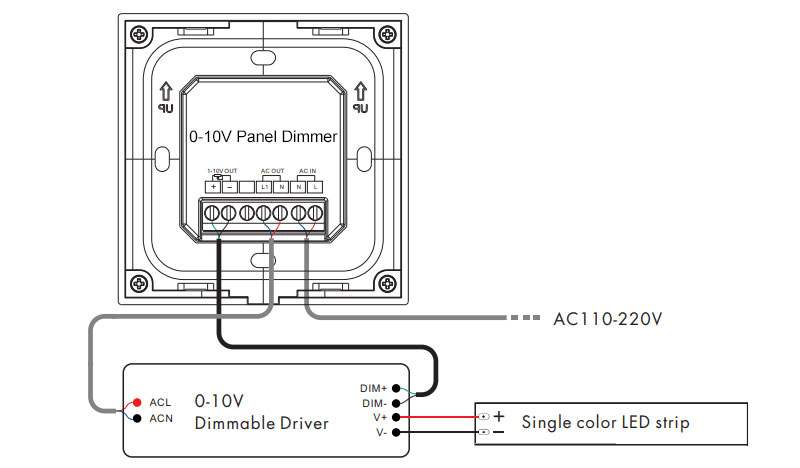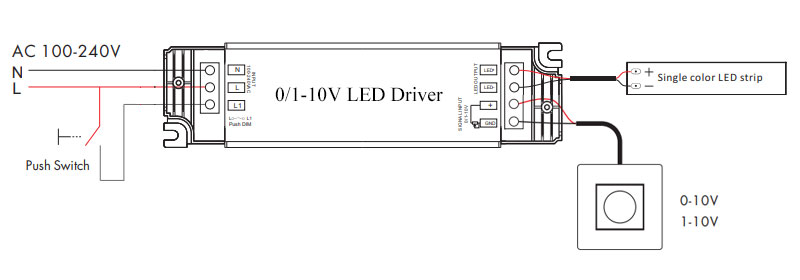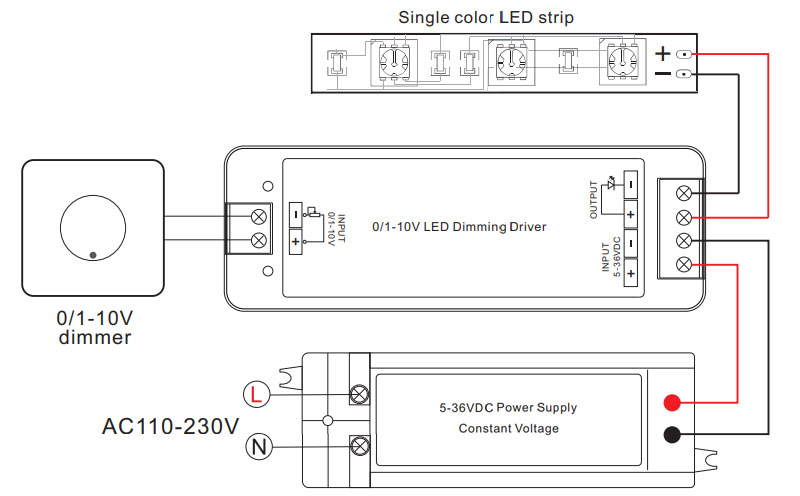Unlike TRIAC dimmers, which are dimmed by TRIAC components on the high voltage side, 0-10V dimmers vary the intensity of dimmable lights such as LEDs, fluorescent, and xenon lamps on a direct current (DC) voltage from 0 to 10 volts.
As one of the three major dimming types, what are the advantages of 0-10V dimmer and what limits you to using 0-10V dimming? This beginner’s guide provides all about 0 to 10V dimmers and 0-10V dimming, take a look now.
What is 0-10V Dimming?
0-10V dimming is a relatively early dimming technology, at the time, this dimming technology is mainly used in fluorescent lamps. Later, with the emergence and development of LED lighting, 0-10V dimming is also used in LED lamps. Although 0-10V dimming technology has existed for a long time, it is still widely used.
In a 0-10V dimming system, the brightness of the light fixture is controlled by a voltage signal from zero to ten volts.
Typically, 0 volt indicates lights off or the lowest dimming level, while 10 volts represents the maximum brightness (In a 1-10V dimming system, 1 volt represents the lowest light level). 0-10V dimmer will adjust the output voltage according to the received voltage signal, thus controlling the light brightness.
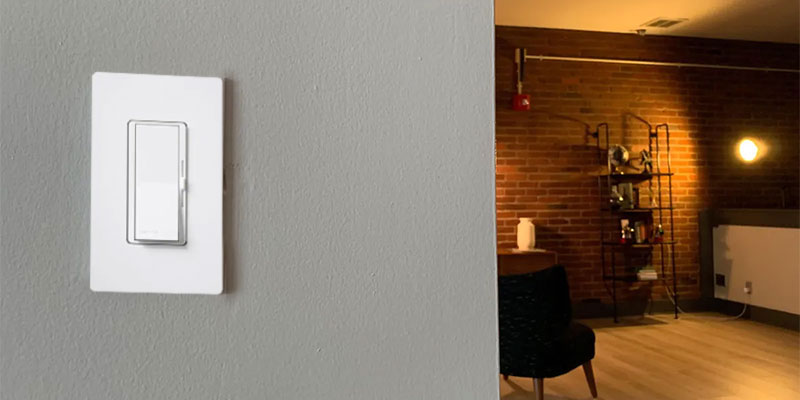
What is 0-10V Dimmer?
A 0-10V dimmer is an electronic dimming device used to control the brightness of dimmable lights. When you operate a 0-10V dimmer switch, remote, or smart home system, your operation will be converted into a dimming signal to be received by the 0-10V controller.
The 0-10V controller converts the received dimming signal into a 0 to 10 volt voltage signal and then sent it to the 0-10V driver. The driver receives the signal and adjusts the light brightness of the fixture to the appropriate level.
0 to 10V dimmer converts the dimming signal into a signal that can be understood by the lighting equipment, thus controlling the brightness of the light.
Take the Lutron DVSTV-453PH-WH 0-10V dimmer as an example, it is designed to control 0-10V LED drivers, fluorescent lamp ballasts and dimmable electronic fluorescent lamp ballasts.
The Lutron Diva 0-10V dimmer has a large toggle switch with a captive linear slide dimmer for precise operation.
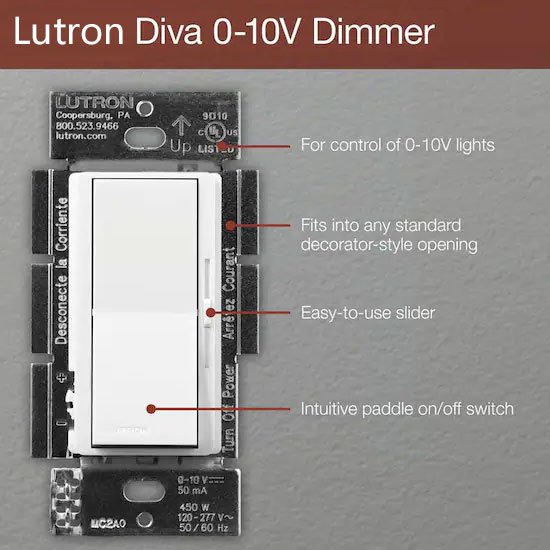
How Does A 0-10V Dimming System Work?
0-10V dimming system requires 0-10V dimmer and 0-10V dimming driver support to work properly for LED strip lights. Please refer to the following 0-10v dimming wiring diagrams:
0-10V Dimmer With AC Input
A 0-10V dimmer usually needs some power supply to work, and this power supply can be AC or DC. Therefore, even if the LED dimmer is based on a 0-10V dimming system, it still needs some power to operate.
0-10V Dimmer With DC Input
When the 0-10V LED dimmer is tuned to the lowest brightness level, the output of the dimming signal should be 0V. This signal is sent to the 0-10V dimmer and converted to a 0V output voltage. After the 0-10V driver receives the 0V input signal, it adjusts the LED brightness to the lowest level.
Therefore, when the 0-10V dimmer switch is set to the lowest brightness level, the LED brightness will also be adjusted to the lowest level.
And when the 0-10V LED dimmer is tuned to the highest brightness level, the 10V dimming signal is converted to 10V input voltage and accepted by the driver, resulting in the LED light strip reaching the highest brightness level.
The Lowest Brightness Level of 0-10V Dimming
In a 0-10V dimming system, the minimum brightness level is usually between 10% and 1%, or even 0.1%, which means the LED strip will still emit a weak light (The minimum brightness level for 1-10V dimming is 10%).
When the dimming signal drops to 0V, the LED strip light should be in the off tate. However, because of the differences between the various 0-10V dimmers, the actual minimum brightness level and the off state may behave differently.
If the 0-10V ballast or driver has a limited dimming range, the light output can only be adjusted from 100% to 10%, a switch or relay must be needed to cut off the power and turn the lights off completely.
Why Do You Need A 0-10V Dimmer?
You need a 0-10V dimmer because it provides flexible, precise, and smooth dimming control. Compared to some traditional dimming methods, such as TRIAC dimming or electronic dimming, 0-10V dimming can achieve a more delicate dimming effect without flicker or color distortion and other problems.
In addition, 0-10V dimming can also support long-distance transmission, making lighting control more flexible and convenient.
0-10V Dimming Applications: homes, offices, restaurants, hotels, exhibition halls, retail stores, etc.
0-10V Dimming in Home and Commercial Lighting
In family life, use 0-10V dimming to control the lighting of main living areas such as bedrooms and living rooms, to create different atmospheres and scenes, such as dimming the lights to create a suitable lighting atmosphere when watching a movie.
In commercial places, adjusting the brightness of lights through 0-10V dimming is conducive to improving the efficiency and comfort of work or life. 0-10V dimming is beneficial for lighting in stairwells, corridors, toilets, etc. that do not need to maintain high brightness all the time.
Benefits And Limitations of 0-10V Dimming
0-10V dimming is now a mature technology that is easy to install and use. Its input voltage is directly proportional to the output brightness, which is a linear dimming method, it means that can provide smooth dimming effect for users to precisely control the lamp brightness.
Although 0-10V dimming can provide a linear dimming effect, it may cause problems such as flickering or unstable brightness of LED fixtures at low brightness levels. This is because small changes in voltage at this time will have a greater impact on the brightness of the lamp.
At present, 0-10V dimming has been standardized, it is compatible with various types of lamps and controllers, and can be easily combined and replaced.
However, 0-10V dimming requires two wires, the control signal and the power signal. There are wire routing constraints during installation which may require additional cost and time.
When the gap between the control voltage of 0-10V dimming and the power supply voltage is large, it may cause the problem of limited control range.
0-10V Dimming vs. PWM Dimming
Regarding the problem of flickering and brightness instability of LED lights caused by 0-10V dimming at low brightness levels, some users may choose PWM dimming instead of 0-10V dimming. PWM dimming is indeed less problematic in this regard.
PWM dimming uses high-frequency pulse signals to control the brightness of LED light fixtures, rather than linearly adjusting voltage or current. This high-frequency pulse can keep the LED fixture at a stable brightness, thereby avoiding problems of flickering and brightness instability at low brightness levels.
However, PWM dimming may cause visual discomfort in some people’s eyes because human eyes cannot quite keep up with high-frequency pulses. In addition, PWM dimming may also cause noise on some low-quality LED fixtures.
Can You Use Different Dimming Methods in the Same Dimming System?
With a special dimmable power supply, you can freely adjust the light brightness with 0-10V dimmer, TRIAC dimmer, and PWM dimmer. Because this dimmable LED power supply will perform dimming processing according to the control signal.
Such a dimmable power supply can adapt to different dimming needs without replacing the power supply or changing the circuit.
0-10V Dimmer Compatible with TRIAC Dimmer
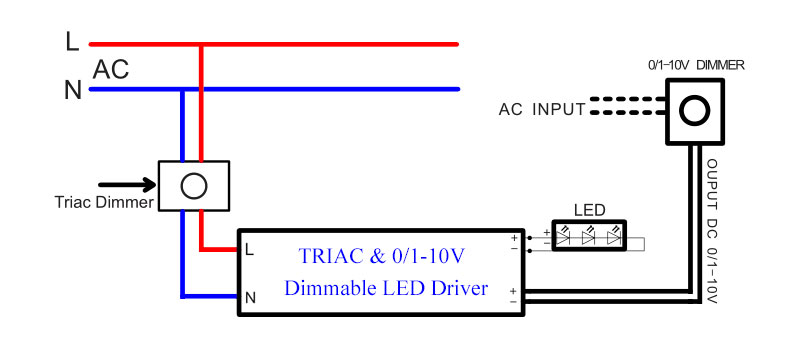
0-10V Dimmer Compatible with TRIAC Dimmer and PWM Dimmer

